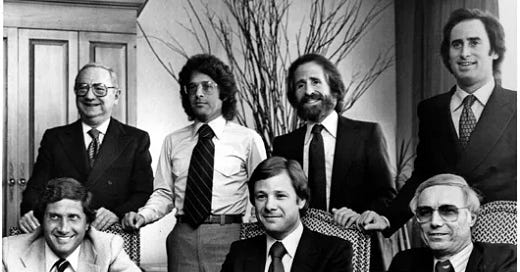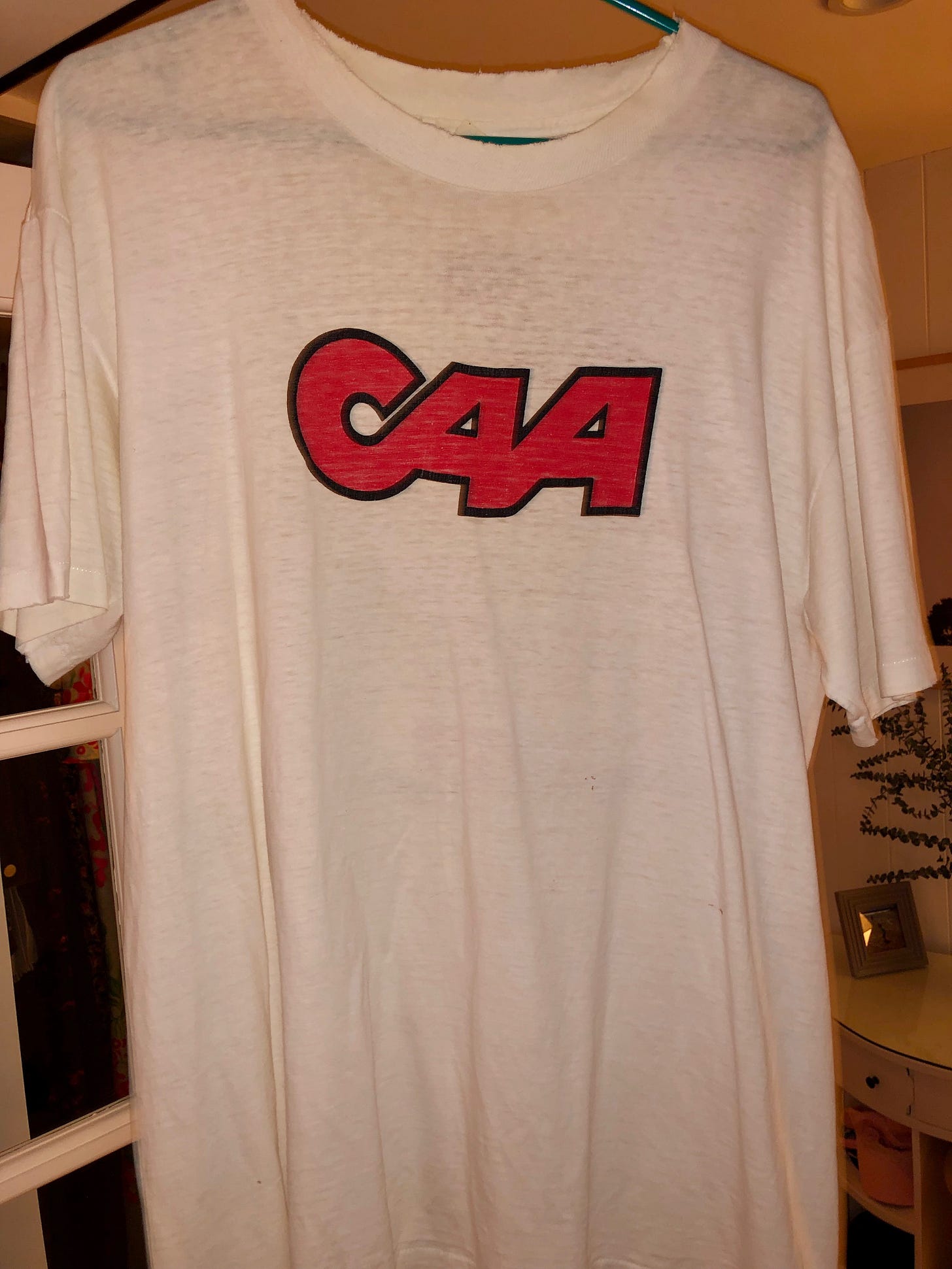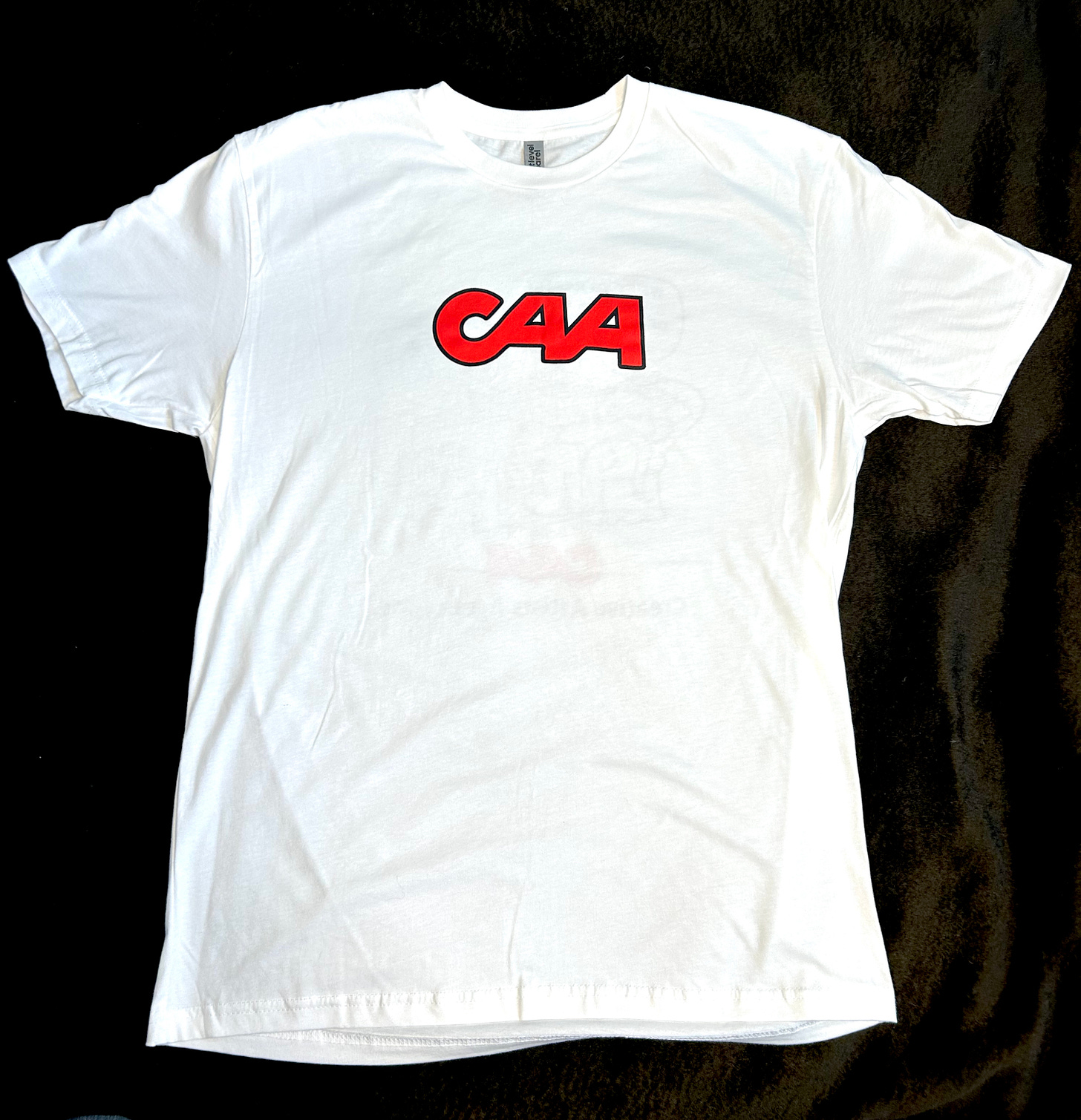In the summer of 1982 I went to work in an office. It wasn’t quite a regular office (or maybe it was; what did I know, at fifteen?) insofar as I could’ve run my finger across any desktop, probably, and numbed my gums with what I collected. It felt like a cross between a zoo, an incredibly cool alternative high school, and a detention center filled with total reprobates, but it was, in fact a talent agency. But if “a talent agency” today conjures images of vast multinational edifices, corporate hives that represent as many YouTubers, TikTokers and politicians as they do movie stars and athletes, this was . . . a mom and pop shop. Even by Hollywood standards it was, then: the company was only a few years old, and if you counted receptionists, assistants, and mailroom workers there were maybe forty-five employees, fewer than half of whom were agents.
The seventies hadn’t really ended, as you can see from the photo above. These guys (with three exceptions, the agents were all men) look a little uncomfortable in their suits and ties. Pictured there are the partners: Bill Haber, Michael Ovitz and Rowland Perkins (seated), Martin Baum (the legend! He’d been agenting since the forties. He’d fought on Normandy Beach!), Ron Meyer—look at that tie! It’s practically a bib! —Michael Rosenfeld, and Steve Roth, who would soon be out on his ear because Ovitz couldn’t stand him. If you know anything about modern Hollywood history, you know who at least a couple of these guys are, and you probably know that the agency they founded, Creative Artists Agency, would go on to become a dominant force in the industry, and that Ovitz and Meyer, especially, would leave a lasting mark. Left out of the frame here is my father, Fred Specktor (I used the term ‘mom and pop shop’ advisedly, literally, above), who came over from the William Morris Agency around the time this photo was taken and who, in fact, is the only person out of all those forty-five employees still working at CAA as I type. CAA now has offices in Nashville, London, Shanghai, Beijing, Stockholm, Munich, New York, Atlanta . . . I mean, they’re everywhere, and the number of employees stretches deep into the thousands, but when I worked there the company letterhead claimed only a few satellite offices (London, Paris, Geneva) that didn’t really exist: they were switchboards, cutouts designed to make the company look big. But ‘Creative Artists Agency’ really was two dozen people on half a floor of an office building, the size of a family law office, and equally as many dogsbodies, of which I was one. I smoked weed downstairs in the garage—and did harder drugs with some of the assistants on weekends—pushed a mail cart down the hall delivering the trades and various deal memos, ran errands (on foot at first; eventually in a car, which I totaled one afternoon making a left on Lankershim Boulevard, as I was trying to get to Universal in a hurry), read scripts. Above all, I sponged it up. I was, naturally, the youngest person working there—I worked long hours during the summer, and shorter ones after school—but would you believe me if I told you it was a fucking blast? It wasn’t just the drugs (very, very good), or the movie stars, or the way that the movies and normal life seemed to bleed into one another. (One summer afternoon, sent out of the office to UCLA Library on a research project, I played hooky, joyriding in a borrowed E-type Jaguar to see Risky Business in a theater, then ran back to the office (stoned, panicking, afraid they’d notice I’d been gone too long), dashing across the lobby and into the elevator to realize, as the doors closed, I was alone with Rebecca DeMornay, looking exactly as she had onscreen twenty minutes earlier.) It was something else, an esprit de corps. It felt like a theater production, or a basketball team: the vibe was loose, chaotic, prankish, loud. An agent might hand me a check for a half a million dollars—no envelope; they’d want me to look at it—and tell me to run it across Century City Plaza to ABC in five minutes flat; Dustin Hoffman (who was borrowing a spare office during the casting of Tootsie) would smoke a cig with me, then convince some actress to chase him down the halls screaming at him just to mess with people. (She chased him into the conference room, where an important presentation was happening: I still remember her shouting, the queasy silence that followed, and the gales of laughter when Ovitz and the others suddenly got that it was a joke.) It felt like the montage sequences in Scarface, or (later) Goodfellas: the good times that unfold as the empire is being built. I was just a bag man—those checks really did feel like suitcases full of cash, as volatile as bombs—but I was a part of it. Later, I would understand what it all meant, that this giddy moment in time was part of a much, much bigger story, one that unfolded across many decades and which gets told in a book I have coming out next week, THE GOLDEN HOUR.
Pictured there is a relic. The CAAgents of 1982 weren’t gangsters, of course, but they had codes as if they were, and they had certain styles, identifying features. They all had vanity license plates (‘CAA’ followed by their initials) that they bolted onto their Porsches and Ferraris—you couldn’t do it if you were a trainee or an assistant; you had to be a Made Guy, a full-service agent—and they traveled in packs. There was a certain T-shirt (this you could wear if you were a junior: I had one) that was made I believe for a company softball game. There were two versions of this shirt I believe (the other was a baseball shirt, with red sleeves), but this was the more common one: company logo on the front, and a cartoon, which plays off a set of ancient Hollywood jokes (an agent will represent anything, including a talking dog, and of course, if your client does happen to be a dog, that dog wants what any other actor or writer client does), on the back. This was a real insiders thing: you had to work there, or be an important client, to have one. You’d slip one of these babies on on Saturday morning (or, if you were Ron Meyer—the one person who almost never wore a suit to the office—during the week), then slide behind the wheel of your Jag or Testarossa, maybe reach into your pocket for a little vial (etc) before you turned the key in the ignition. You were a player, man. You were an aristocrat.
I’d been looking for a version of that shirt for decades. Later (and lamer) agency tees crop up on eBay occasionally, but the original, of which there weren’t very many to begin with, has shown its face to me only once. My friend Chris Levinson, whose father, Richard, was a television writer and CAA client (he co-created Columbo, among other shows), owns one, but it is, as the image above indicates, in tatters. Which is why I decided to enlist my incredibly talented illustrator friend Samia Saad to create one in very small quantities. This was never, after all, an everyman type of item. You had to be someone (or know someone) to have it
Want one? Tap the button below for further details. There aren’t many of ‘em, and they’re made with love and care. Proceeds go to LA Ayuda, an organization offering wildfire relief for migrant workers, and if you want—if you’re quick—you can get with with a numbered-and-inscribed copy of THE GOLDEN HOUR too, so dip on in, won’t you? Your Porsche 911 is sadly not included, but you’ll feel like a Goddamn star when you wear it.
THE GOLDEN HOUR is published in about ten days. If you’re in LA, you should come to Diesel Books in Brentwood on the 22nd (pub day!) to celebrate. I’ll be in conversation with the excellent Tom Bissell, and may have a special surprise or two in order. Details here:
At the LA Times Festival of Books, I’ll be in conversation with my friend Griffin Dunne, moderated by also-pal David Ulin, on April 26th at high noon. This will be great (tickets are required, but they’re freebies)
If you’re in New York, catch me on May 1st at Powerhouse Arena, with the good Jason Diamond. This one’s ticketed too, and it’s gonna rule:
If you’re in the Bay Area, I’ll be with Sterling Holywhitemountain, a true king whose short stories you should get familiar with, at Book Passage on May 8th. There may be some extra trash talking at this one:
And in Chicago, I’ll be at Exile in Bookville on May 15th with Deb Shapiro. We’re gonna try to raise Saul Bellow from the dead (or at least Nelson Algren), but even if we can’t it’s gonna be a hoot-and-a-half.
I’ll hope to catch you out there on the road. T-shirts and tour dates aside, this book is a big deal to me, and involves so much more than the term ‘memoir’ tends to invoke. It’s a real epic. I’m super excited about it, and if you can’t make it to one of the above events (or even if you can! You have friends and family, upcoming birthdays and parents’- and sibling days and party favors to consider, after all) you can get it via an indie bookstore below. Hit it, won’t you? It’s better even than the T-shirt, and the shirt is pretty Goddamn cool.
Until soon—








This is the best pre-credit sequence to a book launch I've ever seen.
See you at Diesel. I think my first round of CAA representation was right around that time. Was Rowland Perkins a packaging guy? I think that later on, Lee Gabler became the packaging heavy hitter - maybe your dad was, too. All becoming a blur…